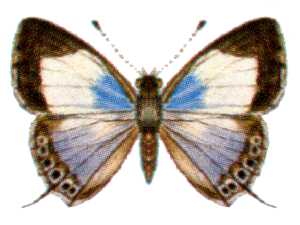Jameela palmyra
| Jameela palmyra | ||||||||||||
|---|---|---|---|---|---|---|---|---|---|---|---|---|

Illustration by Jameela palmyra |
||||||||||||
| Systematics | ||||||||||||
|
||||||||||||
| Scientific name | ||||||||||||
| Jameela palmyra | ||||||||||||
| ( C. Felder , 1860) |
Jameela palmyra ( Syn. Erysichton palmyra ) is a butterfly from the family of Gossamer (Lycaenidae). The species was addedto the new genus Jameela in 2010 by Grund & Eastwood , of whichit is a type species .
features
The two sexes differ greatly in the coloring of the wing tops, but have the same colored wing undersides. The latter have the pattern typical of the Nacaduba section of white-edged oblique bands on a brown background. The front wings have 11 wing veins . The vein R 1 is fused with Sc over a length of about 31% of R 1 . The radial cores R 1 , R 2 and R 4 + 5 arise from the cell . The wire R 4 + 5 rises near the vein M 1 , the wire M 3 is at Costa bent toward. CuA 1 is almost straight, CuA 2 is slightly curved towards the dorsum. The tornus is angular in males. The cell is about 44% as long as the costa. On the hind wings the cell is 41% of the length of the wing at the level of the M 2 vein . The cubitus of the cell is 1: 1.23 longer than the cell radius. The wires Rs and CuA 1 originate from the cell, CuA 1 originates in the vicinity of M 3 and 3A measures about 62% of the length of 1A + 2A. A short, thread-like tail is formed on the CuA 2 core . The arch at the tornus is poorly developed. The scent scales on the upper sides of the wings are shaped like a shuttlecock, wide rectangular, tapered at the base and rounded to rectangular at the end (terminal). They have 16 to 18 ribs. The compound eyes are hairy. Your REP (reflective eye pattern) is of type III (white pigmented). The antennae have 33 to 37 segments and are about half the length of the Costa. They are piebald and have a yellowish-orange antenna lobe that is flattened in prepared animals. The labial palps point upwards. They are more powerfully built in the males than in the females. The proboscis is long. The legs have a single pair of dorsal sensory hairs apically . The splints ( tibia ) of the middle and rear legs are apically provided with spurs.
Occurrence and way of life
The species is distributed from the Moluccas through New Guinea and Queensland as well as on the Bismarck Archipelago and the Solomon Islands .
The caterpillars of Jameela palmyra have been detected on belt flowers (Loranthaceae). It is only known that they are fully grown reddish-brown and resemble those of Erysichton lineata , but differ from these by a smoother surface of their horizontally flattened (onisciform) body. The pupae of the species, like the eggs, are unknown.
Taxonomy and systematics
In 2010 the species was moved by Grund & Eastwood together with Jameela albiplaga from the genus Erysichton to the newly established genus Jameela , which means that Erysichton now only includes the type species Erysichton lineata and is therefore monotypical .
The following subspecies are assigned to the species Jameela palmyra :
- Jameela palmyra palmyra ( Felder , 1860); Syn .: Nacaduba hyperesia Fruhstorfer , 1916; Nacaduba poecilta Holland , 1900; Nacaduba Valentina Grose-Smith , 1895
- Jameela palmyra tasmanicus ( Miskin , 1890); Syn .: Lycaena elaborata Lucas , 1900; Lycaena tasmanicus Miskin , 1890
- Jameela palmyra lateplaga ( Tite , 1963)
- Jameela palmyra coelia ( Grose-Smith , 1894); Syn .: Nacaduba coelia Grose-Smith , 1894; Nacaduba subvariegata Rothschild , 1915
- Jameela palmyra clara ( Tite , 1963)
supporting documents
Individual evidence
- ↑ a b c d Roger Grund, Rod Eastwood: New Australian butterfly genus Jameela gen. Nov. (Lepidoptera: Lycaenidae: Polyommatinae: Polyommatini) revealed by morphological, ecological and molecular data . In: Entomological Science . No. 13 , 2010, p. 134-143 , doi : 10.1111 / j.1479-8298.2010.00368.x .
- ↑ Toshiya Hirowatari: A generic classification of the Tribe Polyommatini of the Oriental and Australian Regions (Lepidoptera, Lycaenidae, Polyommatinae) . In: Bulletin of the University of Osaka Prefecture . No. 44 , 1992, pp. 1-102 .
- ↑ Markku Savela: Erysichton Fruhstorfer, 1916. In: Lepidoptera and some other life forms. Retrieved November 16, 2014 .